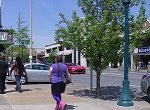City Planning With Kids May Give New Insight into the Future of the Community
Last Updated: October 11, 2023
City planning with kids is a wonderful and unpredictable activity,
sometimes offering insights and usually offering whimsical spins on
public issue discussions. Children will offer simple, straightforward
observations about the great characteristics of your city. Let's start with explaining that a bit more; if you have already decided on this approach, you can skip ahead to the suggestions heading.
Involving school-age children and young people is certainly a more lively experience than asking adults for opinions about the
future of land use, transportation, or the local economy.
When asked what kind of real estate development they do want, in
the positive sense, often adults modulate their responses depending on
the trust level they have established with their local government. Children and teens may just blurt it out in a way that actually moves the dialogue toward telling the truth.
Adults typically just get up and speak, sometimes making a personal
attack and sometimes speaking emotionally, but often they've been
coached to behave well. Occasionally someone shows up with a dead bird
or photos of the trash blowing around a fast food drive-through lane.
That's about the extent of the adult drama. Children, tweens, and teens are more unpredictable and therefore just more fun.

However, we want to point out that besides their truthfulness, there are other major advantages to involving children in the community planning process. They are the true stakeholders, meaning those who really will see the results, good or bad, of the town planning decisions that the community makes.
The American Planning Association has really accentuated city planning with kids in recent years, even providing some resources for learning how to do so.
The fun thing is that if you want to involve school children in a planning process, especially the younger ones, you can't really anticipate everything they will say and do. If you're brave enough to ask younger children, those in grades 1-6, what they want to see added to the neighborhood, they'll have ideas aplenty.
Often the first comments are wildly self-interested, so children and young teens will request outdoor video games, ice cream, balloons, fountains with soda
instead of water, Santa Claus landing in a hot air balloon, and such.
Then usually they settle down and start being very honest.
They will want to see more people around, more places for Grandma to sit down, more salons where Mom can get her hair highlighted, more choices for something that would interest Dad, and music on Sunday.
They want to see the traffic moving faster but they don't want to have to walk as far to the store. They want that ugly roof to be taken off. They want the street to be cleaner. Flowers would be nice. And a place for their dogs to get a drink.
They comment that it's ugly when people leave their chewing gum in the drinking fountain or spit on the street. They want the pigeons to stop pooping. And please, could we do something about downtown soon because it is so b-o-o-o-ring.
City planning with kids is bracing and refreshing in its honesty. It can help the adults to see things in a new light as well.
Suggestions If You Decide to Try City Planning with Kids
Before we offer some pointers on better inclusion of the next generation, we have to issue a stern warning to governmental entities. Don't even think about manipulating children into endorsing your pet project or plan. If we can't appeal to your ethics to get you to agree with this proposition, perhaps you at least will see that this is counter-productive when the children mature enough to realize they have been exploited. Just be careful not to use city planning with kids for cynical and selfish purposes.
That being said, there is still a lot to like about children at the table. Here are some tips for success :
- Strongly consider modifying your techniques to fit a generation that has grown up with cell phones and screens. Beef up your city planning with kids by sending them out to take photos with their phones of the things they like and don't like in their neighborhood. Our experience has been that this should be this works well as the very first exposure of young people to planning. There's no need to give them a lot of direction--just the prompt to photo what they find appealing and repulsive. This will get the discussion started.
- Send them links to very short surveys based in Survey Monkey or some other online platform; they will feel very safe and anonymous through expressing their opinions online.
- Organize a web-based scavenger hunt for a photo or scene that is relevant to your planning process.
- Working with teens and older children, we have overcome skepticism by asking them to advise us on how to use technology to make your neighborhood planning more exciting. They become so interested in helping us poor tech illiterates navigate the tricky waters of social media that even before they know it, they slip into becoming interested in the content of city planning problems.
- If you are able to progress to actually evaluating alternatives, just as with adults, explain in advance that you might not be able to provide everything they request. (We started that statement with "if" because sometimes, despite your best efforts, you are never able to move beyond issue identification when you are working with young people. If that happens to you, as it has to me, you should still regard youth input as valuable.)
- Offer a few interesting pieces of trivia related to your subject that you think will intrigue the children.
- Employ art materials, building blocks for younger children, found materials for older children, and plenty of photos to engage the eye as well as the brain. If you can record sounds or present tastes relevant to the project, that's also helpful.
- Age-appropriate budgeting exercises help older children express their priorities. A budgeting exercise can be anything from asking them to distribute these five green dots to their most preferred alternatives and three red dots to the ickiest items, to actually dropping play money in jars. These exercises are too frustrating for grades 1-4 though.
- Feel free to mix children with adults in public workshops and forums, especially if there is a strong visual element to the problem at hand.
- Keep in mind the typical attention span of the age groups with which you are working, as well as the vocabulary.
- Weigh children's input appropriately according to how expert they are on the subject you're studying. If you are planning a school, park, or playground, they may well be better than adults at spotting a deal breaker. But they might be close to useless in planning a port.
- As with adults, anticipate the problems of domineering and difficult people. With children, I've been successful with just "accidentally" placing all the loudmouths together, where they can see who can yell loudest, while the other small groups get some work done.
- For best results, isolate children from their own parents or any other authority figure in their lives that might inhibit their expression. In other words, don't put the fifth grade teacher at the table as the recorder.
- Remember that abstraction skills develop reliably about high school time, although of course it's possible that you have a very precocious child or two. So city planning with kids doesn't mean map work, unless it's mind maps you're seeking. They're pretty good at free association. If you need to work with where something goes, use blocks or another three-dimensional object.
- One exception to what we just said is that I have had some success with using drone footage to help young teens figure out the geography. A visitor to this website communicated that she had actually taught some 13 and 14 year olds to fly her drone and thus rekindled their flagging interest in helping with a small area plan.
- Recognize that city planning with kids could bring out the tendencies toward meanness against any "outsider" groups that aren't present. So don't take those reactions too literally.
- Reward them with an age-appropriate trinket for a job well done at the end of the allotted time.
We also suggest that you incorporate children right into committees and dialogue groups with adults after they have had a little orientation to the planning question. If you let them know that their opinions will be taken seriously by not relegating them to the "children's table" like Thanksgiving dinner, they often will respond. Ask children, tweens, and teens to contribute good ideas, and ask adults to listen respectfully without jumping in to criticize or laugh at every idea they express.
But in your eagerness to include young people, there is no need to fall into the trap of acting as if the participation of kids and teens is so unusual that you need to comment on it at every single opportunity. If you do this, they will sense that what they are doing is atypical and that it is unlikely that they will ever be asked to serve in a responsible capacity again until they are adults.
Better Inclusion of Children in Planning Work
Children can participate in an actual design charrette (a concentrated design experience focused on a particular geography), if you follow our guidelines.
For more suggestions on how to present community subject matter to kids, see the link.
A terrific activity kit, which is available in several different formats, is called Box City. This isn't to be confused with the stores of that name of course.
For inspiration, you can read a description that one of our site visitors submitted of the Kids Can city project.
Good luck with your children's charrette, or just better inclusion of students in community planning.
Pages That May Be Related to City Planning with Youth
Join USEFUL COMMUNITY PLUS, which provides you monthly with short features or tips about timely topics for neighborhoods, towns and cities, community organizations, rural environments, and our international friends. Unsubscribe any time. Give it a try.





